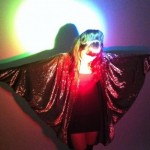I’ve always seen Robyn as the gateway drug into pop music. She’s the kind of singer who can make an anti-pop punk appreciate a melody, or a lo-fi fanatic see the brilliance in good production. And it isn’t just the craftswomanship that Ms. Carlsson employs to design such perfect pop songs, it’s her conviction and her delivery: when you listen to pop music, you’d better be convinced of what the singer is selling, and with her controlled abandon and elastic-silk voice, she sings every song as though her life depends on it. That quality, along with her pop-princess royalty status and DIY ethics, make Robyn such a fascinating artist.
Let’s flash back to the late ’90s, a little while after her 1995 debut Robyn Is Here started to catch on. I am a pre-teen from a small town in British Columbia with nothing but TV, country radio and my parents’ record collection to dictate my musical taste. It was during this time that I was introduced to Robyn with her breakout hit “Show Me Love,” a regular on a program that all of you Canadians under 40 will remember called The Hit List, a weekend show on YTV (Canada’s youth television channel). Every week they would count down the singles of the week and Robyn was always on the list amongst the likes of Spice Girls and the Moffatts (the Canadian version of Hanson). I like to think I watched this program with a sense of irony, or at least an awareness of how awful some of the music was. But Robyn stood out. Her voice was engraved into my young brain, into my very psyche, and became as familiar as Bob Saget’s face from Full House. I was hooked.
In the years to come, Robyn would release two more records, My Truth (1999) and Don’t Stop the Music (2002), via BMG. I’m sure they did well in Europe, but it was only when she started her own label (Konichiwa) and began releasing records on her own, (partnering with various labels for distribution) that she re-entered the insular American pop culture bubble of marshmallows and mascara. I mean, who didn’t freak out when they heard “Be Mine”? It’s perfect. And the Body Talk EPs? If you do a pie chart of touring rock bands’ personal soundtracks, I think you will find that a good 3/4 of the chart would be taken up by “Body Talk Listeners.” I’ve seen the scraggiest of punks melt at the sounds of “Indestructible.” It’s a sight to behold and a power to respect. The pop singer, when used correctly, is the perfect peacekeeper and anti-depressant.
Now, in 2014, Robyn is here, with the Norwegian electronic duo Röyksopp at her side, to release Do It Again, a five-song EP of sad dance anthems and comedown mood pieces. It’s shockingly satisfying for an EP, as though they’ve covered all corners of the dance music universe in under 60 minutes. (It is bookended by two 10-minute-long epics.)
There is a small part of me that is disappointed about not hearing more Robyn-esque total-club-abandon-girl-power jams. (The title track is the closest they come to classic Robyn.) But this isn’t a Robyn EP, I must remind myself, this is a collaboration. Both Robyn and Röyksopp have said they want this EP to be viewed as the work of a band, not one artist featuring the other. So fair enough. I can deal.
First song “Monument” is an opus. It is sombre in mood, including the line “This will be my monument/this will be a beacon when I’m gone.” It has a sense of finality, almost like a swan song, which makes for an interesting opening track. This nearly 10-minute epic ends with an Air-meets-Roxy-Music saxophone jam, soft and moonlit as you descend from the high and walk home alone.
“Sayit” is a jerky club affair with pulsing, repetitive, classic Röyksopp robotic vocals and the occasional club dialogue: “I want you/I want you too” and “pleasure machine/funk mechanic.”
Track three brings us the goods: “Do It Again” is so Robyn. I just want to dance with my best gays and shoot tequila all night long! This is good old-fashioned euphoric molly-popping music (as the kids say these days), with perfect analogue synth-bass bouncing all over the place and some excellent warm ARP-like hits giving it a syncopated energy. Lyrically, there are lots of clichés: “Don’t care what they say/It hurts so good,” but it’s exactly what a dance-pop song should be: one giant earworm into a rabbithole of gold, silver and black strobe lights reminding you that you are still alive and your pension years are far, far away.
“Every Little Thing,” my favourite track, acts as the sombre sister to “Do It Again” with a sexy half-time beat, arpeggiated synths and a gorgeous chord progression, while the lyrics reflect on a love on the outs. The EP ends with the instrumental “Inside the Idle Hour Club”; with its ambient, airy, atmospheric sounds, it would be a keen fit with a sci-fi film soundtrack, perhaps for a film about a futuristic, dystopian Tokyo.
I picture Röyksopp and Robyn’s own idle hour club as a sonic kitchen, filled with synthesizers and tequila, somewhere in Scandinavia, far from the pressures of the music industry to produce a diet equivalent. Do It Again is an Oreo of a record, for lack of a better analogy: Dark, deep and rich sonic cookies give a backbone to the soft, fluffy interior. Some EPs leave you wanting more, but this is complete. Sweet and satisfying, familiar and fresh, Do It Again is best served with a glass of nostalgia to the finest DJ’s and nightclub fanatics.









